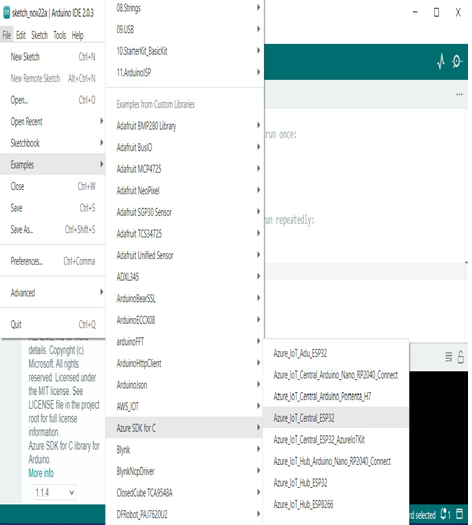Building the inventory management system – Architecting Complex, Holistic IoT Environments
By Patrice Duren / August 18, 2023 / No Comments / AWS Certification Exam, Case study of Amazon, Microsoft Exams
With the libraries ready, we can start building the implementation of the inventory management system:
First, we must write the Arduino code to read distance measurements from the ultrasonic sensor and transmit the data via MQTT. The code is based on the example of Azure SDK for C with some modifications and combined with AWS SDK codes. Open this chapter’s GitHub repository and locate this practical to get through this section easily.
To start, we need to open the Azure SDK for C example file in the Arduino IDE by going to File | Examples | Azure SDK for C | Azure_IoT_Central_ESP32. Once the code has loaded, we need to save the sketch under another name so that we can modify it. Click on File | Save As and name it ESP32_Azure_AWS_BME680:

Figure 14.12 – Opening the Azure SDK for C sample code
The connection parameter settings are located in the iot_configs.h tab, so we need to click on this tab. In this example, we will not use the X509 Certificate option; instead, we will use DEVICE_KEY. To enable a connection to Azure IoT Central, we need to change the contents of iot_configs.h. You need to replace IOT_CONFIG_WIFI_SSID and IOT_CONFIG_WIFI_PASSWORD with your Wi-Fi credentials, and DPS_ID_SCOPE, IOT_CONFIG_DEVICE_ID, and IOT_CONFIG_DEVICE_KEY with the values you saved when you configured Azure IoT Central.
Look for the following lines and replace them in the file accordingly:
// Wifi
#define IOT_CONFIG_WIFI_SSID “YOUR_WIFI_SSID”
#define IOT_CONFIG_WIFI_PASSWORD “YOUR_WIFI_PASSWORD”
// Azure IoT Central
#define DPS_ID_SCOPE “YOUR_DPS_ID_SCOPE”
#define IOT_CONFIG_DEVICE_ID “YOUR_DEVICE_ID”
#define IOT_CONFIG_DEVICE_KEY “YOUR IOT_CONFIG_DEVICE_KEY “
Click on the main tab – that is, ESP32_Azure_AWS_BME680. We also need to change the code here. Source this code directly from the project code in this book’s GitHub repository. You may delete the whole code first for easier programming.
Write or copy these codes accordingly, as per the project code.
Since we moved the sensor reading to the main program and to accommodate sensor measurement parameters, we need to modify Azure_IoT_PnP_Template.cpp. Again, we can source the code from the project repository on GitHub.
We need to add a new tab to store the AWS certificates. Create a new tab by clicking on the button near the top right of the window and clicking the New Tab option. Name the tab certificates.h. Change THINGNAME (if you’re using another name) and AWS_IOT_ENDPOINT and insert the appropriate three certificates that you saved when you created your thing via AWS IoT between BEGIN and END:
#include <pgmspace.h>
#define CERTIFICATES
#define THINGNAME “ESP32_DHT”
const char AWS_IOT_ENDPOINT[] = “YOUR_AWS_IOT_ENDPOINT”;
// Amazon Root CA 1
static const char AWS_CERT_CA[] PROGMEM = R”EOF(
—–BEGIN CERTIFICATE—–
—–END CERTIFICATE—–)EOF”;
// Device Certificate
static const char AWS_CERT_CRT[] PROGMEM = R”KEY(
—–BEGIN CERTIFICATE—–
—–END CERTIFICATE—–)KEY”;
// Device Private Key
static const char AWS_CERT_PRIVATE[] PROGMEM = R”KEY(
—–BEGIN RSA PRIVATE KEY—–
—–END RSA PRIVATE KEY—–)KEY”;
Now, we can look at testing our implementation.